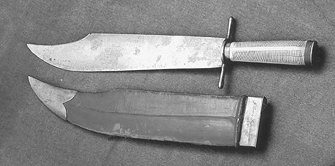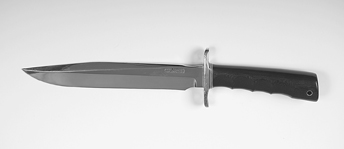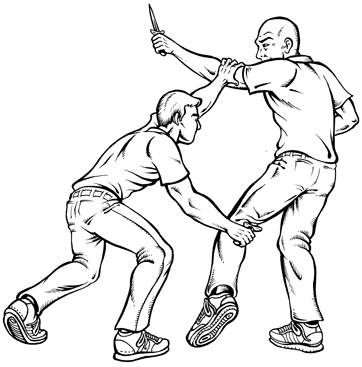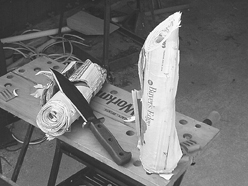Read Hank Reinhardt's Book of Knives: A Practical and Illustrated Guide to Knife Fighting Online
Authors: Hank Reinhardt
Hank Reinhardt's Book of Knives: A Practical and Illustrated Guide to Knife Fighting (17 page)

Modern reproduction Bowie, 14 inches overall length.
HRC129

A historical Bowie; the blade alone is 14½ inches long.
From
The Antique Bowie Knife Book
, Charles Schreiner III collection
The most highly publicized story of its use occurred at the first session of the Arkansas General Assembly in 1837. A bill offering bounties for wolf hides sparked an argument between Rep. Major J. J. Anthony and House Speaker John Wilson. After several insults were tossed at each other, Wilson descended from the Speaker’s platform. And when they reached the bottom step each man drew his Bowie knife.
Perhaps in hopes of averting a fight, someone shoved a chair between them. But Anthony and Wilson each grabbed a part of the chair in his left hand and began slashing with his right. Anthony cut downward at Wilson’s left wrist and almost severed it from its arm. He then threw his knife at Wilson, but it failed to strike on its point and fell to the floor. Wilson then thrust his knife to the hilt into his foe, and Anthony collapsed and died a few minutes later.
Wilson was arrested, expelled from the House of Representatives, but later was acquitted in trial on the grounds of “excusable homicide.” It was bloody episodes like this that energized Southern legislatures to outlaw the Bowie knife.
There are also several states where a great many knives are illegal due to blade length and design. Before you carry any knife on your person it is up to you to contact your state attorney general’s office and determine the exact wording of the law. Don’t follow the advice of some potential jailhouse lawyer, or the opinion of a friend who says, “They told me it was okay.” Don’t even pattern your knife-carrying habits upon what you read in the newspaper, or watch on television. Do your research and find out the facts.
Now, here are some choices for a current Bowie knife. One that Hank and I both had fondly desired is Randall’s No. 1.

Randall No. 1, 12½ inches overall length.
HRC601
This is an excellent choice; probably the best is the seven- or eight-inch blade. This knife is fast with good point speed and, although hollow ground, it has a good deal of edge toughness. It can be bought in several different handle styles from stag to Micarta. In addition, an excellent, high quality sheath comes with the purchase.
Another fine example is Cold Steel’s Laredo Bowie. On the ones I’ve tested so far, the factory edge has been book-cutting sharp. It is a well designed knife with good handle qualities and a very strong flat grind. If you are fairly tall, six feet or above, it’s very easy to carry a Bowie knife in the twelve-inch length. But if you’re shorter, one of seven or eight inches is the better choice.
The custom world is full of Bowie knives. You can afford to be choosy. The next time you talk to a custom knife maker, you need to sound him out on these subjects: Will your knife be tested before he delivers it? The test should include flexing the blade and watching it return to true. Edge-holding ability should be tested as well. Your custom blade should cut a hundred pieces of one-inch manila rope without going dull. You should be able to drive your knife into a hardwood board without bending the point. You should be able to cut through a two-by-four plank at least three times, and the handle should be tightly mounted afterwards.
If your custom bladesmith’s knife won’t pass these tests, then it’s better to find someone else’s work that will. If you must tote a Bowie, then stick one in your sheath with a blade from eight to twelve inches in length, well tested, and book-cutting sharp.
FIGHTING WITH THE BOWIE
When it comes to fighting with your Bowie, you are well armed. Like the kukri in the previous chapter, you have tremendous cutting power at your command. If your knife is well designed it should have terrific point speed. You can achieve deep penetration, wider wound tracks, and the ability to move in and out very quickly.
As you face your adversary, you can beat him to the cut by using the Reinhardt Snap, slicing him across his fingers, the inside of his forearms, or the top and outside of his wrist. Also, a lightning quick thrust to the opponent’s hand is now possible. Driving the point two inches into his wrist or hand is a good start. Equally neat is a quick thrust to the inside of his thigh, using the sharpened back edge of the Bowie and using the arterial illustration for your key targets.

Human arterial system.
A lighting quick straight line thrust to the front of your opponent’s throat, or a quick snap cut across the carotid arteries of the neck—these are some of the moves that make the Bowie a superior fighting tool.
If you miss a cut, you can easily snap back underneath to cut your opponent’s forearms or inside his thigh, by using the Bowie’s back edge.

Snap back underneath to cut the thigh.
Some suicidally inclined antagonists have committed the folly of trying to snatch a Bowie away from a foe by grabbing that long blade. This is a losing game if the back edge is properly sharpened. If someone grabs the top of your knife, give it a quick twist to the left, then yank it backwards, breaking his grip and cutting his palm.
Now that you are aware that your Bowie can cut in both directions, practice this in your sparring. But don’t neglect additional practice with inanimate objects. In the previous chapter we used the kukri to slice water-filled jugs. Practice this with your Bowie as well. Get out your length of free-hanging manila rope, and blaze away with the Reinhardt Snap, whacking off pieces of rope until the act comes easily. Now stack two water-filled soda cans and practice cutting the top one in half without turning the bottom one over. You can also roll up newspapers.

Practice with your Bowie until the art of cutting comes easily.
Photo by Whit Williams.
Remember, the only way to learn how to cut is to cut. You need to constantly practice to keep your strength and speed up.
And while you are keeping yourself in shape, don’t forget the health of your knife. Test your Bowie knife constantly by cutting free hanging rope. Keep both the point and the edge sharp, And if you buy a custom blade make sure the bladesmith has cut through at least one two-by-four, and has flexed the blade at least 24 degrees out of line and seen it return to true.
THE DAGGER
Now, for man’s oldest self-defense knife: the dagger.

Reproduction bronze dagger, 11 inches overall length.
HRC175.
I don’t think there is any shape that has been praised or cursed as much. Critics of this shape will tell you it’s not very strong, that it has very little cutting power. But you need to look at the dagger not as a tool but purely as a weapon. The point isn’t very strong if you try to lever up rocks, or dig up roots with it. But if used for its intended purpose, the dagger is one of the most versatile fighting designs.
It can be forged very light and thin, which makes it a joy to carry. It has the ability to cut in either direction. It’s very difficult to snatch a well-shaped dagger from somebody’s hand; a pyramid shape is hard to hold onto.
EVOLUTION OF THE DAGGER
One of man’s oldest fighting knife shapes is a piercing weapon. It doesn’t matter whether it was made of wood, stone, or metal. Its advantages are many. In the early era of armor, a dagger-shape point would push through links of mail, and in a later period easily through the visor of a knightly helmet.
The dagger shape is primarily an awl-style with two parallel edges and it makes for a wonderful fighting blade. The ability to cut in many different directions expands your attack and defense in different ways. So, not only can it be used as a penetrating weapon, but properly designed and sharpened it makes an excellent tool as well.
Many early daggers were of bronze. Although bronze is an excellent material, it still has many flaws. Its inability to withstand shock is one of them. Even with this drawback, it is more than strong enough for excellent penetration. As we progress to the era of iron and steel, the ability to cut with a dagger shape becomes a reality. A very common medieval shape, the baselard, is an example of strength in both its ability to cut and penetrate.
